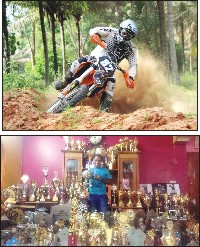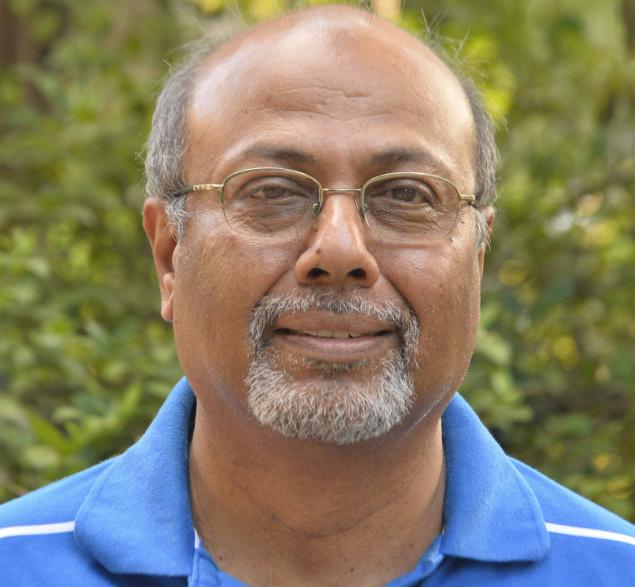Motorcycle racing is one of the most exciting and thrilling competition one could see. The riders or skilled racers risk serious injury or worse to become champion. Racers are part of the bike and both the machine and rider have to work in harmony.

Mysuru city has produced good racers and one such racer is Abdul Wahid Tanveer, fondly called as Tanni by his fans.
This bike-riding fanatic is the youngest member of a family full of motocross riders, who started racing (Dirt Track) when he was studying in class eight at St. Mathias School in city.
Tanveer’s skills have led him to scoop a collection of medals and trophies. “I had a room full of trophies and medals, but I gave away some to my fans as mementos as I did not have place to keep them all,” said Tanveer with a grin.
Tanveer, speaking to SOM, said that he was crazy about motocross racing since a kid and the interest grew when he used to see his elder brother Abdul Majid, a National-level bike racer practice.
He said that his first race was when he was studying in eighth standard where he finished fourth and added that this encouraged him to practice more to become perfect. In the next year, when he was studying in ninth standard, he won his first title ‘Best Rider’ award by riding his modified Yamaha 135 two stroke and Yamaha YBX 4 stroke bikes.
His father late Mohammed Shafi, a wrestler, popularly known as Chirag Pailwan, who was a timber merchant and his mother, a housewife, initially refused to allow him to go racing as he was the youngest and the most pampered kid in the family.
But when he overcame all odds and won the first title in the National-level racing in Bengaluru while he was studying in 10 std., his parents began to encourage him and from then, there was no looking back for Tanveer, it was only winning trophies and medals.
Tanveer, who joined TVS as a racer in 2014, has won many championships including MRF Championship and Rally De Bengaluru in 2014, where he was the overall champion, Dakshin Dare Rally in 2015 in which he was adjudged as the ‘Best Rider’ in the Ultimate Bike category and an Overall Champion.
He has won races in Kerala, Tamil Nadu, Hassan, Chikkamagaluru, Coorg and other places in the country and aims to make it to the Great Himalayan Rally this year. He says “I have participated in all categories in different events and Indian Open Class is my favourite.”
Tanveer said, “You got to finish to win. Of course, you got to be fast to win too, otherwise everybody would be doing it.”
This year, Tanveer has participated in over 25 races, both local and National and has won prizes in all.
He is now participating in the MRF Championship which is being held in six rounds in Ahmedabad, Chennai, Hyderabad, Coimbatore and Pune. Of which, three races have been completed with the first held at Ahmedabad, the second at Coimbatore and the third at Chennai.
He said that he now leads the race with 12 points and the remaining three races will be held at Hyderabad, Bengaluru with the final race to be held in Pune.
When asked which bike he uses for the races, he said that he races in three groups and uses three different bikes such as a custom made TVS 300FX for Group-B, custom made Apache RTR 180 for Group- B and Apache RTR 160 for Group-C and said that he enjoys riding his Apache RTR 180.
Speaking about injuries, Tanveer said that in 2014, when he was leading in the MRF Championship, he crashed during a practice session and suffered elbow fracture besides suffering from severe burns as the bike fell on him leaving him hospitalised which resulted him being out of the race.
When asked if racing got encouragement in Mysuru, Tanveer said that there is no encouragement for racing in Mysuru and it was only his family members and a few friends who are encouraging him from the beginning. He said that earlier, Zabiulla, a mechanic near Ya-allah Masjid, used to tune his vehicle when he began racing.
He also said that as there was no encouragement, he had stopped racing for a year in 2012 and added that it was a person from Kerala who persuaded him to continue and it is then he began to race again and continue his winning streak.
Speaking about precautions to be taken during racing, Tanveer said that it is always necessary to wear safety equipment, no matter what the circumstances, wear well fitting Motocross Protection equipment, if you are just starting out, take things slow, find an experienced person who knows about Motocross to give you tips, do some practice before you race, keep in mind that your protection is always more important than winning and finally, do not be afraid to race.
Strength Training
Tanveer said that racers need a strength training programme that targets key muscle groups and keeps them in balance. He said that his strength training is based on four principles that improves not only the strength but the lap time too.
Tanveer says concentrate on your back as the back muscles are equally important in maintaining a proper riding stance. A weak posterior chain will lead to a slumped posture and fatigue the chest, shoulders, arms, and quads, more rapidly leading to general fatigue.
Strong Core Muscles are Key: Proper training of the core region is needed to maintaining proper form and function during a race.
If the core muscles are weak, a rider will alter his posture and riding position, therefore transferring work to the weaker shoulders and arms. When this happens, the arms, shoulders and even legs do more of the work and become fatigue quickly.
Weight Train for Strength not Endurance: Motocross racers are experts at endurance training and therefore usually weight train for endurance. But lifting heavier weights for fewer reps is necessary for building strength.
Concentrate on Total Body Movements: The key to an efficient total body strength programme is to incorporate exercises that require the use of multiple joints versus isolation exercises.
Giving his piece of advice to youngsters, Tanveer said “The streets or roads are not racing tracks,” this should be always in the mind of youngsters. Do not race on streets as it will not only cause problems to the riders but also to others which is against the law. While on road, follow traffic rules.
It does not matter if you are the smoothest rider or you are out of control, pain does not discriminate and wearing proper safety gear could save you, or someone else from a painful experience, Tanveer said.
source: http://www.starofmysore.com / Star of Mysore / Home> Feature Articles / by S. Kenneth Shishir / September 18th, 2015










